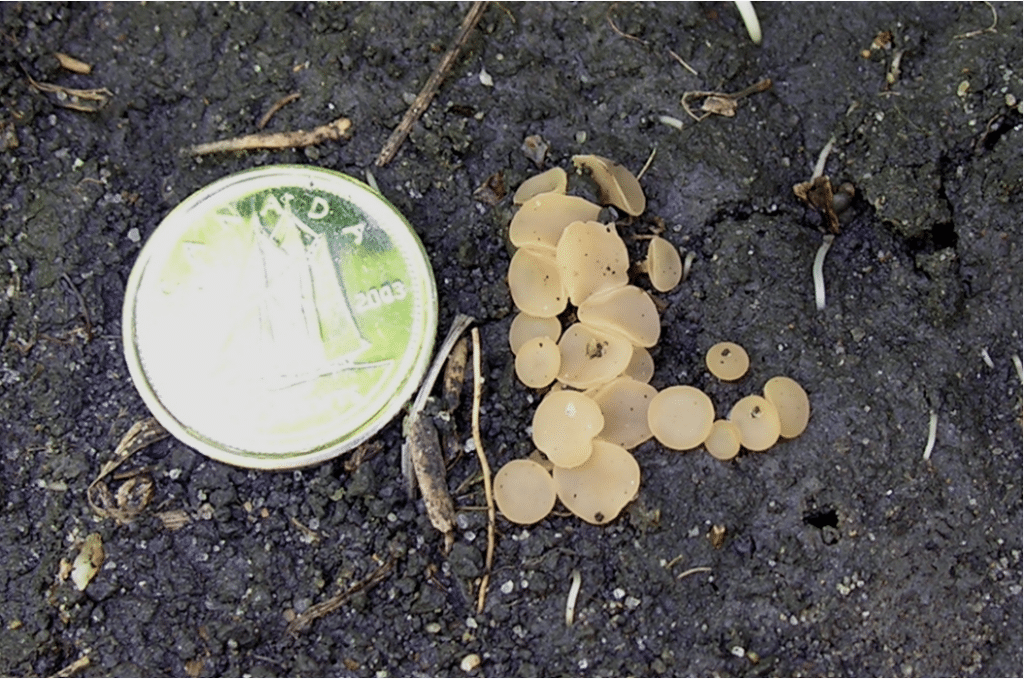Key Result
This research project showed that the biocontrol agent Coniothyrium minitans (CM) reduced the survival of sclerotia of S. sclerotiorum under field conditions. Yield increases due to the application CM were also evident and would translate into significant savings for producers.
Project Summary
Overview
Sclerotinia sclerotiorum is one of the most important pathogens affecting canola and other susceptible crops such as dry bean in western Canada. In canola, even a yield loss of 3% would cost producers approximately $13M yearly. Stem rot of canola and white mould of bean caused by S. sclerotiorum, can be managed by fungicide use but timing of applications is critical.

The biocontrol agent Coniothyrium minitans (CM) reduces disease and may have long‐term benefits for sclerotinia‐susceptible rotational crops such as canola and bean. Timing, rate selection and application strategies for the biocontrol agent may affect the development of sclerotinia disease and may have the potential to become an important Integrated Pest Management (IPM) tool for management of sclerotinia stem rot of canola. This three‐year project addresses these issues and provides new information regarding the impact of C. minitans on canola disease levels, yield, and inoculum potential of S. sclerotiorum for subsequent crops and years. In addition, the proposed research will help to identify optimal times for spray application and may indicate a larger window of opportunity for control as compared to fungicide application.
Outcomes
Research trials were located at Morden and Brandon, Manitoba on sites that were naturally and artificially infested with S. sclerotiorum. Treatments for canola (cultivar Invigor 2663) included a combination of 3 CM rates, low, medium and high, and 2 foliar application times, 20‐30% bloom and 50‐60% bloom. An untreated control and a fungicide treatment (Ronilan) were also included, and in the last year of the study, treatments of CM applied to the soil were added.
The study results showed that CM reduced the survival of sclerotia of S. sclerotiorum under field conditions, with fewer sclerotia recovered in the CM‐treated plots compared to the untreated controls. The results of field trials where C. minitans was applied to the aerial parts of canola plants during flowering stage showed a reduction in sclerotinia stem rot of canola in many of the biological control treatments compared with the untreated controls. Although there was considerable variability among sites and locations in the effect of application timing on disease, CM applied at the 50‐60% bloom appeared to be more effective against sclerotinia stem rot of canola.
Foliar applications of CM were also more effective than soil application. Yield increases due to the application of the biological control agent were also evident and would translate into significant savings for producers. The study also showed that soil application can reduce the survival and therefore the inoculum potential of S. sclerotiorum. However, because the ascospores of this pathogen can be dispersed by wind currents there is a potential for infection from outside the area of treatment.
The incidence of sclerotinia stem rot has been positively related to the percentage of flower petals infested with ascospores of S. sclerotiorum at the early bloom stage in previous research. In this study C. minitans was recovered from canola flower petals, and was still viable on the petals after three days. Preventing or reducing colonization of flower petals by S. sclerotiorum with the application of C. minitans appears to be a valid strategy for management of sclerotinia stem rot since less disease was observed with the application of CM at some sites in some years.
This project and other related research on evolving pest management systems for canola and other sclerotinia‐susceptible crops is important in the move towards more environmentally sound and sustainable cropping systems.
Related research
Turkington, T.K, Kutcher, H.R., McLaren, D. and Rashid, K.Y. Managing Sclerotinia in Oilseed and Pulse Crops. Prairie Soils and Crops 4:105-113.





